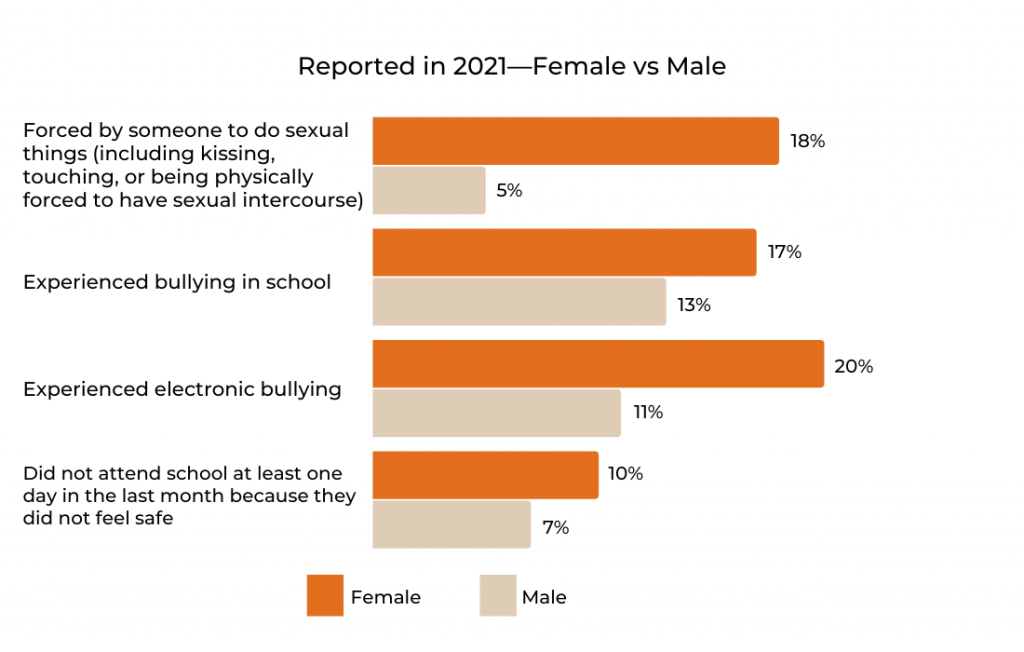YRBS Shows Increased Mental Health Issues and Decreased Sexual Activity Among Young People
This month, the CDC released data from the 2021 Youth Risk Behavior Surveillance System (usually referred to as the YRBS). The survey asks current high school students about their experiences and behaviors related to a wide variety of issues that could impact their physical and emotional health. Students are asked how often they wear bike helmets and seatbelts, whether they’ve ever experienced violence or held a gun, and if they smoke cigarettes or use marijuana and other drugs. They are also asked about their mental health and their sexual behavior.
The survey has been conducted every two years since 1991 and offers a view of trends in teen behavior over time. The data from this first post-pandemic survey suggests that today’s young people are struggling in many ways. In a trends report, the CDC notes that bullying and substance use have gone down but acknowledges that the rest of the news is not good: “Unfortunately, almost all other indicators of health and well-being in this report including protective sexual behaviors (i.e., condom use, sexually transmitted disease (STD) testing, and HIV testing), experiences of violence, mental health, and suicidal thoughts and behaviors worsened significantly.”
Mental Health and Social Isolation
Most notably, the pandemic seems to have exacerbated mental health issues that had already been increasing over the years. The YRBS found that 42% of teens experienced persistent feelings of sadness or hopelessness in 2021 compared to 37% in pre-pandemic 2019 and 28% in 2011. In addition, 22% of high school students had seriously considered suicide (up from 19% in 2019 and 16% in 2011) and 10% had attempted suicide (up from 9% in 2021 and 8% in 2011).
Dr. J. Dennis Fortenberry, a professor of pediatrics at Indiana University School of Medicine and former ASHA board member, says this suggests a true mental health crisis in this country and argues that we need to shift how we approach it. He said, “We need to think about mental health from a public health perspective. It can’t just be thinking about every kid having their own therapist because that’s not practical and there just isn’t the kind of workforce to cover it. We need to start helping young people with their mental health at a younger age and begin to think about it in the context of the social isolation young people feel.”
A Decline in Sexual Behavior among Teens
This social isolation is also apparent in trends related to sexual behavior as well. When the YRBS began over half of all high school students had had sex (54%) and by senior year that was up to 67%. There has been a slow and steady decline in teen sexual behavior over time, and in 2021 only 30% of high school students reported having ever had sex. (Note: the YRBS only asks about intercourse so this may not be a complete picture of what young people are doing sexually.)
The CDC labels this decline in sexual behavior as a positive trend because it helps protect young people from STIs and unintended pregnancy, but even some of its own experts question what the change in behavior says about the lives of today’s teenagers. Kathleen Ethier, director of CDC’s Division of Adolescence and School Health (CDC-DASH) which is responsible for the study, told the Associated Press that this might be a reflection of kids making healthy decisions to delay sex and have fewer partners, “but what concerns me is this is potentially a reflection of social isolation.”
Fortenberry agrees. He noted that sexual development is a normal and important part of adolescence. In early adolescence, young people begin to feel attracted to others and to want to be seen as attractive and worthy of connection. Fortenberry says it looks like many kids might be missing out on that developmental milestone: “There is nothing in the YRBS data that will let us pinpoint it, but I do think there’s an association to be made between mental health and sexual behavior as there seems to be a clear increase in isolation, depression, and anxiety, and a lack of sense of connection among our young people.”
Fortenberry thinks public health messages and politics may have contributed to this, “I always say we get the teenagers we produce. I think there’s been intense promotion on the dangers of sex for a long time because we were anxious about teen pregnancy and STIs and then HIV.” He added, “I don’t think it’s an accident either that these young people reached adolescence in a time where there is a consistent emphasis on the denial of almost everything related to sexuality.” Fortenberry’s own state of Indiana recently passed a law that will prevent trans kids from getting the gender affirming care they need.
A Disproportionate Negative Impact Among LGBTQ+ Youth
The YRBS does not give us much information about gender as there are no questions asked about gender identity (though the agency says it plans to add some in future versions). It has asked high school students about their sexual orientation since 2015 and the percentage of kids identifying as LGBQ+ has increased from 8% to 15% in that time. Unfortunately, the data suggests that these young people are among those suffering the most.


In addition, despite the lower percentage of teens having sex, those students who are having sex may not be protecting themselves. The data found that among those students who were currently sexually active (defined as having had intercourse in the three months prior to the survey), 48% did not use a condom the last time they had sexual intercourse putting themselves at risk of STIs, though most did use some form of contraceptive. Only 13% used no form of protection.
STI rates among young people are not declining which is hard to explain given the lower rates of sexual intercourse. It could be that the decline in condom use among those who are sexually active puts this smaller group at increased risk. (In 2005 63% of sexually active high school students reported using a condom the last time they had intercourse, this number dropped to 54% in 2011 and 52% in 2021.) It is also possible that some young people are engaging in other sexual behaviors that carry a risk of STIs but are not asked about on the YRBS.
ASHA President Lynn Barclay said, “This most recent YRBS paints a picture of a generation of young people who are in need of increased sexuality education and improved mental health care. Adults from politicians to parents have to step up for our kids.”